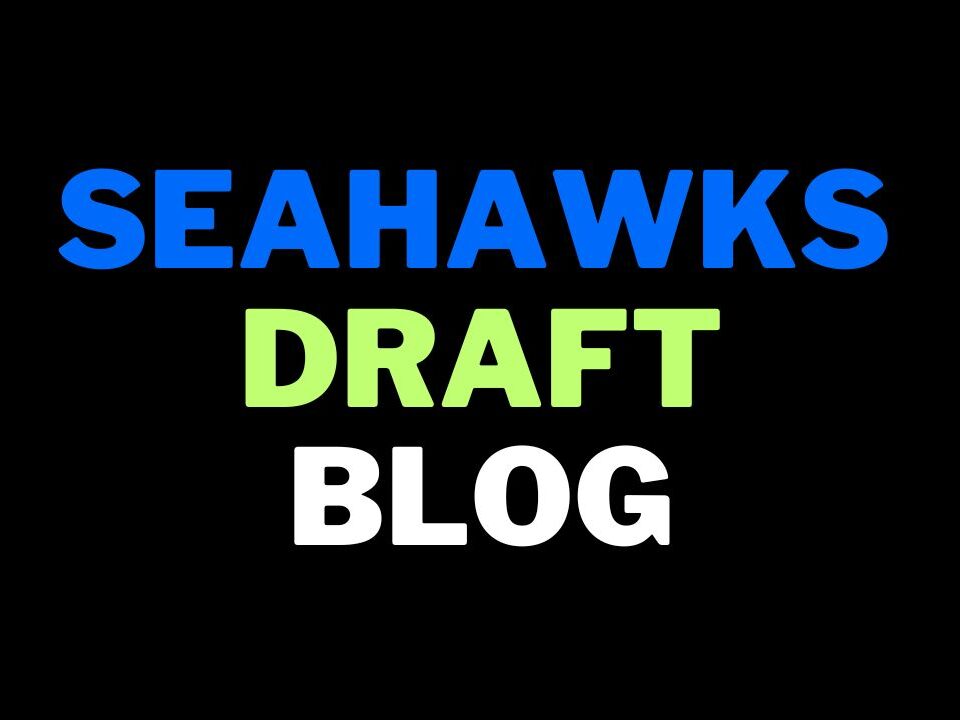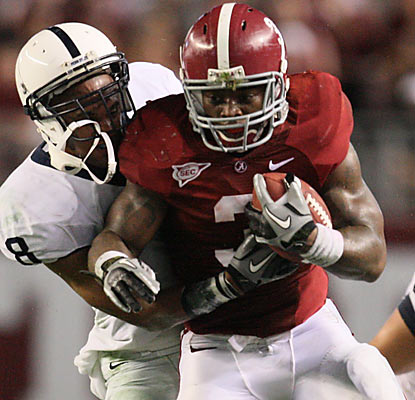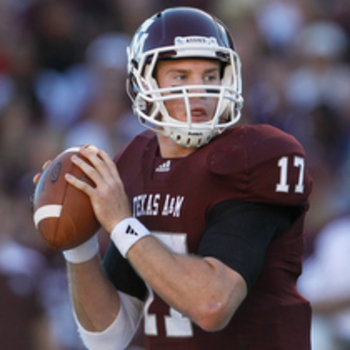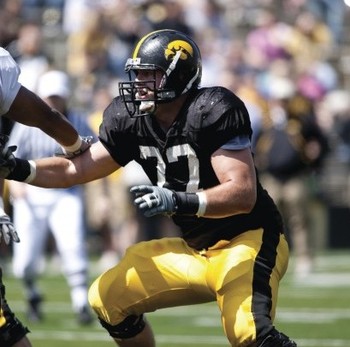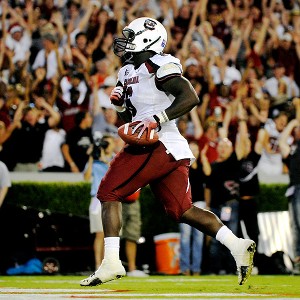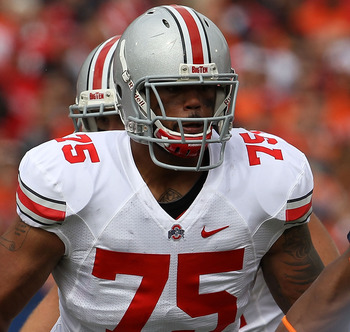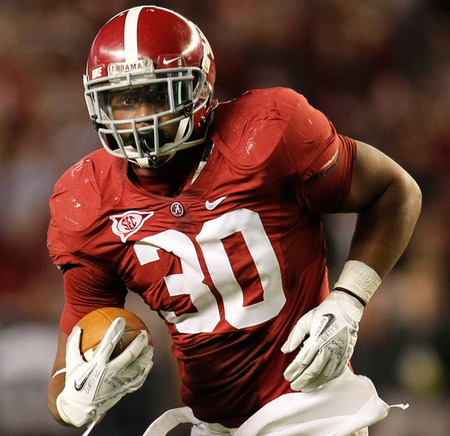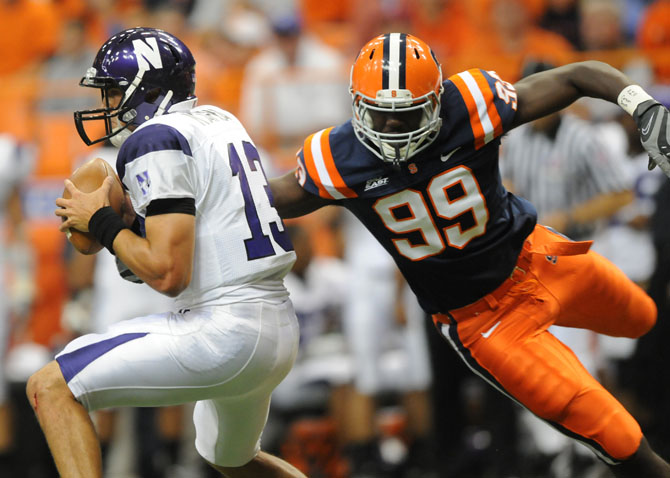
Quarterbacks receive too much credit when the team wins, and too much blame when the team loses. Mark Sanchez's first 3 years are a monument to this truism.
Written by Kip Earlywine
Every now and then, Rob and I are privy to some insider Seahawks information from a proven and reliable source. In the case of the Carson Palmer trade which Rob reported last year, he decided to go public with that information after confirming it with two NFL sources- but its worth noting that neither of those sources was our usual guy, and when Rob asked him about it, he never confirmed or denied what we had been hearing about talks between Cincy and Seattle last year. I personally think there really was something there with Palmer, but because then first-place Oakland got desperate and overpaid after Campbell went down last year, we’ll never really know how accurate the information really was. I bring this up because I want to defend the credibility of our source, who had nothing to do with that report- even if it ends up being true. Pretty much every piece of information the source has given us has more or less been proven later.
This source has recently been in contact with Rob, who in turn has relayed some information to me. Obviously, Rob and I are Seahawks fans first and we understand the importance of information warfare this time of year. A lot of the stuff we have been told could do real damage to Seattle’s offseason plan if we carelessly leaked it. But that said, we do have some insider knowledge. Let me say right now that a Mark Sanchez trade is NOT a part of that. We have no confirmation or denial that a Sanchez deal is in the works to Seattle, based on what we’ve heard. However, Rob and I both feel that it is a significant possibility regardless, and worth discussing on the blog since obviously it would impact both Seattle’s search for a quarterback and the draft picks they’d have at their disposal in April. Again, this is all speculative. This is not a scoop.
Anyway, the last couple months have been pretty interesting for the Jets, to say the least. They lost their last 3 games of the season to finish 8-8 after entering the season with high expectations. Rex Ryan stripped his team captains of their leadership titles. The Jets’ locker room became a poisonous caldron that could scarcely contain itself. Jets receiver Plaxico Burress took what could be considered a passive aggressive swipe at his quarterback at an autograph session. Reports of a feud between Santonio Holmes and Mark Sanchez were laid bare by LaDainian Tomlinson on a recent television appearance, though in fairness to Sanchez, many other sources have painted Holmes as a bit of a headcase in 2011. I won’t repost the entire Tomlinson article above but here are some parts of it that I found revealing:
The Sanchez-Holmes rift was “as bad as I’ve ever been around,” LaDainian Tomlinson revealed in a television interview. Tomlinson, the latest player to characterize the dissension-torn locker room as The Florham Park Zoo, said he’s not sure if Sanchez and Holmes can co-exist. The future Hall of Famer claimed the locker-room problems “got out of hand” toward the end of the season, adding that coach Rex Ryan and general manager Mike Tannenbaum fueled the mentality because they like players that speak their mind.
“You know, it was at the point where I think the players could no longer do anything about it. There was nothing that the players could do. So when it gets to that point, there are certain changes that need to happen. Can it be fixed? I think absolutely it can be. But they’re going to have to make some tough decisions.” If he were the GM, Tomlinson said it would be a “tough one,” the decision on whether to keep Sanchez and Holmes together.
Tomlinson, reiterating what he said last Sunday on ESPN’s NFL Countdown, refuted a claim by one unnamed player telling the New York Daily News that Sanchez is “lazy.” But he did say the Jets need a backup to push him.
“I would say a bit pampered because he has no competition,” Tomlinson said. “He has no real threat to say, ‘This guy may take my job.'”
Tomlinson said Sanchez can overcome the turmoil, but “he just has to have pieces around him to help him get it done.”
The New York Daily News interviewed several Jets players and a “Jets source” last month, and some of the findings were rather shocking. The “Jets source” did not seem negative towards Sanchez, but also made it clear that he would happily ditch Sanchez in a New York minute for Peyton Manning, even saying it was a “no-brainer” and that it would be “stupid” for the team to avoid trying for Manning. Among players interviewed, the tone was almost universally negative towards Sanchez. Not everything the players said is on the level- for example one player accused Sanchez of being “lazy” which has been widely disputed elsewhere. It doesn’t take much time to read the expose, but in case you decide to skip it, there is one part that really jumps out to me:
Some in the organization told The News that many of Sanchez’s teammates have grown resentful [of Sanchez] for myriad reasons.
“They see the organization babying him,” said a Jets source. “They see him with a sense of entitlement. He’s been given all this and hasn’t done anything. They call him ‘San-chise.’ They make him the face of the organization. They gave him the captain tag. He’s not a captain. He should have never been a captain.”
None of the players who spoke to the Daily News for this story agreed with Ryan’s decision to anoint Sanchez as a captain.
It should be clear at this point that the Jets badly want to win the Manning sweepstakes and have both Manning brothers in New York. Most league observers consider this unlikely. However, given how incredibly damaged Mark Sanchez has become among Jets fans and players in his own locker room, it seems very plausible that Sanchez’s days in New York could be numbered regardless. From perusing a few Jets fan sites, I get the impression that Jets fans are receptive to the idea of getting what they can for Sanchez and moving on, whether they get Manning or not. And as highlighted above by Tomlinson, its unclear if Sanchez and Holmes can coexist in 2012.
That’s significant because Holmes signed a five year, $45 million deal just before last season, and he was owed a $7.5 million roster bonus of sorts yesterday, meaning that if the Jets cut Holmes now, they will be $7.5 million poorer than if they had cut him on Tuesday. If the Jets were to side with Sanchez in their dispute and jettison Holmes, this would have been the time to do it. The deadline came and went. Holmes will now officially remain a Jets player in 2012.
Woody Johnson, owner of the most unfortunate name in history and also the New York Jets, set up a rather suspiciously timed face to face meeting with Sanchez- set for just after that Holmes deadline. As Tomlinson alluded to, keeping both Sanchez and Holmes would be difficult; tough decisions will have to be made. It seems distinctly possible that New York could be considering an early exit from the Sanchez era. Even if Sanchez and Holmes mend fences, which both he and Holmes are attempting but seems unlikely, there is also the fact that Sanchez has a large amount of antipathy in his own locker room. It could be an environment poisoned beyond repair. A change of scenery might be necessary for both parties, and soon. Regardless of whether Manning is signed by the Jets or not.
If the Jets are looking to trade Sanchez, it seems unlikely he’d get a huge return. Sanchez’s image is pretty damaged around the league- fairly or not- and consensus (from my own research) seems to indicate that he would command something like a 3rd or 4th round pick in a deal. Jets fans I’ve encountered seem pretty receptive to the idea of trading Sanchez and getting something for him now instead of potentially nothing later, and dealing Sanchez would also have the side benefit of taking them off the hook for his $14.2 million salary cap number in 2012. Sanchez posted mediocre (though improved) statistics in 2011, and could be easily replaced by someone like David Garrard, Kyle Orton, or Jason Campbell without feeling much- if any- short term pain. Dealing Sanchez quickly could also increase the Jets slim chances of landing Manning, and they are expected to at least try for his services.
If Sanchez is dealt, and it increasingly appears this could be a very real possibility, there is no more obvious destination in the NFL than Seattle. Regardless of our personal opinions on Sanchez, he clearly fits the high upside low cost “value” acquisition Seattle has frequently targeted under this regime. Guys like Mike Williams, Leon Washington, LenDale White, Kentwan Balmer, Marshawn Lynch, and Brandon Browner. A lot of Sanchez’s problems could be cured with a change of scenery, being forced to compete for his job, having better teammates around him (both as players and as people), and being part of an environment that is friendly but also stresses accountability. As we saw with White, Carroll holds his former USC players to the same standard as everyone else. Playing as far away as possible from the New York media would probably help too.
Pete Carroll commented recently that he wants there to be a real competition at quarterback in 2012. If all goes to plan, we won’t see a repeat of last year where Jackson was the unquestioned starter from day one. Making this goal reality is harder than it seems though. It would be difficult to achieve true competition through any rookie other than Luck or RG3, and as we understand things, the odds of either being a Seahawk next year are extremely slim. Cousins and Weeden are NFL ready relative to most mid round quarterbacks, but its doubtful they would provide much of a threat to Jackson in August of 2012. To make this statement a reality, they would probably need to add a veteran who is roughly the same caliber of quarterback as Jackson. Orton, Campbell, and Garrard could be options, but Seattle showed no interest in either Garrard or Orton when they were free agents during last season, and the team made no effort to trade for Campbell which is saying something since the Raiders acquired him for pennies on the dollar from the Redskins.
Mark Sanchez has slightly improved every season, and last year, his overall statistics were pretty close to Jackson’s. Their passer ratings were within a point of each other (78.2 vs. 79.2). Jackson posted a significantly higher yards per attempt, (6.9 vs. 6.4), but its worth noting that Sanchez’s YPA was fairly robust early in the season before issues with his receivers developed. Only 50% of Sanchez’s attempts to Holmes were completed (worst in the NFL among pairings with 100+ attempts). While I would give the statistical edge to Jackson last year, you kind of got the feeling that Jackson was near his ceiling as a quarterback (at least mentally), and Sanchez is still improving despite having a ton of distractions and problems in 2011.
Further, Jackson was playing a game manager role whereas the Jets leaned on Sanchez to be a playmaker. Sanchez had a 26-18 TD/INT ratio last year compared to a 14/13 ratio for Jackson. It could be that Sanchez could benefit from playing in a less demanding game manger role in much the same way that Jackson did in 2011.
It should be noted that while Jackson was a very poor quarterback in the red zone last year, Mark Sanchez was the NFL’s 5th best red zone quarterback and led the Jets to the NFL’s #1 overall red zone offense, despite the fact that the Jets overall offense ranked just 25th. Having a quarterback who isn’t afraid to make tight throws could help Williams and Obomanu bounce back after both felt the loss of Hasselbeck last season.
While it no longer seems that Sanchez is a sure-fire franchise quarterback, it is at least credible to say that he’d provide a very real challenge in August for Tarvaris Jackson, much more of a challenge than a mid round quarterback like Cousins or Weeden. Its also possible that a change of scenery, a reunion with his old coach, and the motivation of having to “earn everything” (one of Pete’s slogans in Seattle) could help Sanchez blossom into a solidly above average quarterback. And even if a Sanchez acquisition fairs no better than the acquisitions of Balmer or White, the Seahawks will have likely lost less in that deal than what they lost in Charlie Whitehurst, who to me was a far inferior gamble then compared to Sanchez now.
Finally, its worth noting that connections matter to this front office. The team very nearly signed Matt Leinart last summer before he opted to play for the Texans. Multiple sources told us that Seattle was involved in talks with Cincy regarding Carson Palmer. The team signed Tarvaris Jackson in large part because of his connections to new offensive coordinator Darrell Bevell. Even Josh Portis had some connections to Pete Carroll through his college offensive coordinator Walt Harris, whom Portis credits for developing him into a point guard quarterback. Harris and Carroll worked together while in New York and both held coaching positions in the Pac-10 for a time.
There are three possible hangups to a deal. The first is salary. Sanchez is basically on a 2 year, $22 million contract and that would certainly have to be restructured.
The second issue is Carroll himself- has Pete Carroll forgiven Mark Sanchez for leaving USC early? The normally positive and upbeat Carroll was visibly upset with Sanchez for the decision to go pro in 2009, after Carroll worked hard to convince Sanchez into staying. Rob recently reached out to Scott Enyeart (a USC beat writer who also follows the Seahawks) and Enyeart mentioned that Sanchez was never as close with Carroll as he was with Steve Sarkisian and that the relationship between the two was fractured possibly beyond repair when Sanchez declared.
The third issue are the reports of the Jets cancerous locker room- how much of that is Mark Sanchez’s fault? From the reports I have read, Sanchez comes across as a hard worker and a dedicated teammate, and I get the feeling that much of the discord is simply a bi-product of adversity coupled with a few big egos which have been poorly managed by the coaching staff- which is never a good combination. Regardless, this is certainly something that would require looking into.
From the Jets’ side of things, they have given zero indication that they would trade Sanchez up to this point, but with the start of trade and free agency still five weeks away, it would be shocking to hear them say anything else, as it would invite an intense media storm at a time when the Jets can least afford it.
Is Darren McFadden on the trading block?
Oakland is entering the post Al Davis era in perhaps the most painful way possible. The team’s new GM wants to install a west coast offense and a zone blocking running game, but the team is roughly $15-$20 million over the salary cap and only has only a 5th and 6th round pick to spend in the 2012 draft. Despite the fact that Michael Bush is expected to leave in free agency, rumors are surfacing that Oakland could look to use star running back and former #4 overall pick Darren McFadden as a 2012 trade chip. Trading McFadden wouldn’t just add some desperately needed draft capital, it would free them from the last two years of a 6 year, $60 million contract he signed in 2008. McFadden was the first draft pick by the Raiders during Tom Cable’s turn at head coach.
Its not completely clear if Cable and McFadden would have mutual interest in reuniting though. McFadden struggled in Cable’s version of zone blocking scheme and did much better after Cable left. Still, McFadden is a very talented running back who could interest Seattle as a “value” acquisition, depending on what Oakland’s asking price ends up being. I think Seattle would probably prefer to draft a running back instead, but its not out of the question that they could pursue a veteran to bolster the running game- if they feel the price is right.
